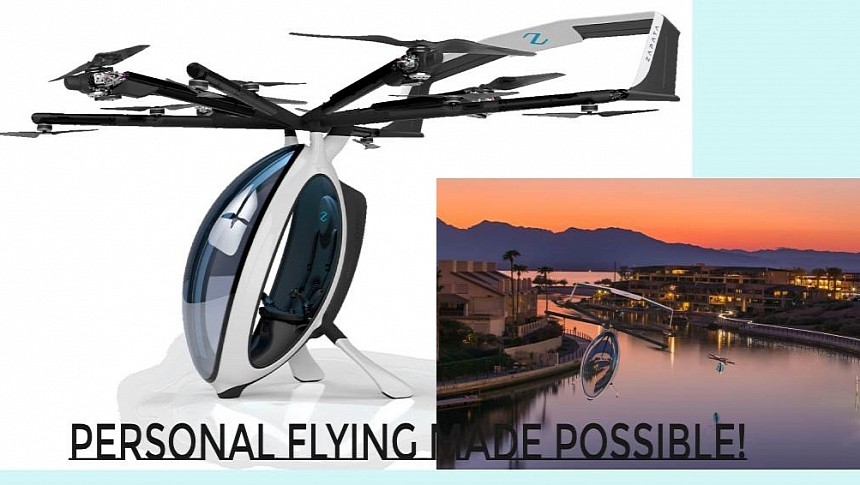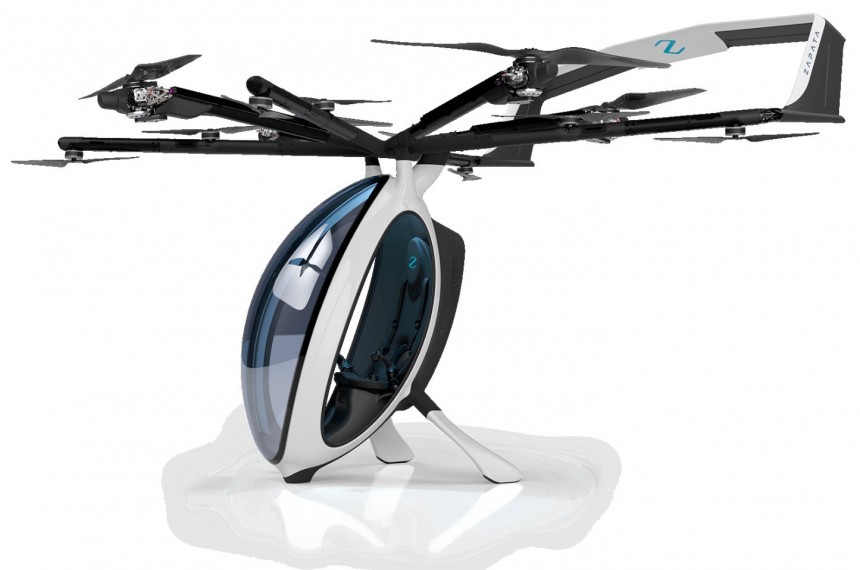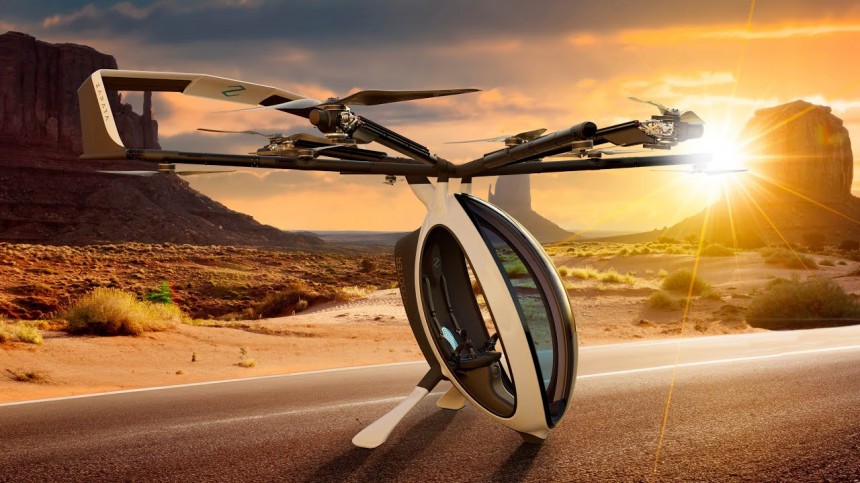Man's decades-long dream of achieving personal flight and of integrating it into the daily routine isn't as close to becoming real as we'd like it to be or would be led to believe. But Zapata is set on taking us a step further – and closer to that dream.
Zapata is a name that must ring familiar to anyone watching the niche sector of innovative water and micro-turbo jet-propelled platforms. The founder, Franky Zapata, is nothing short of a pioneer, having developed a range of products from the FlyBoard to the JetPack and the JetRacer, machines meant to make man overcome his physical limits.
The latest machine will go one step beyond by turning the sky into a new starting point. The AirScooter, introduced in June 2023 by means of a live model, is still in the early planning stages, which is a bummer for us because it means the entire list of specs has not been revealed.
On the bright side, at least the wait will be worth it. The AirScooter is presented as the "world's most advanced personal flying machine," a little egg-shaped VTOL (vertical takeoff and landing aircraft) with hybrid propulsion and the longest range in the industry because of it. It's a scooter that flies, offering convenient and fast transportation for the pilot and some cargo without as much as the need for a pilot's license.
This is the stuff that (modern) dreams are made of, and that's no exaggeration. It's the stuff of sci-fi movies, where you skip traffic jams on the highway and congestion in the city by hopping into your one-person flying machine, zapping from point A to point B with ease and minimal costs. Most importantly, with the AirScooter, you'll also be doing it without the much-dreaded range anxiety because Zapata is opting for hybrid propulsion instead of the industry-standard electric.
The AirScooter is an egg-shaped machine of very compact dimensions - 340 cm x 340 cm x 256 cm/ 11 feet x 11 feet x 8 feet, to be more exact, and only 115 kg (253.5 lbs) in weight, though maximum payload will be of 120 kg (264.5 lbs). It features a fixed tricycle strut landing gear and six rotors arranged in pinwheel formation on top, with the Distributed Electric Propulsion (DEP) feature that provides redundancy in case one of the working propellers malfunctions.
The cabin is encased in glass on three sides, which offers excellent visibility for the operator and, at cruising speed, breathtaking panoramic views. Thanks to the hybrid propulsion (there's also an 18.9-liter/4.9-gallon gas tank on board), the AirScooter comes with an estimated flight time of 2 hours, which puts it ahead of VTOL competition because most other products of this kind focus on offering pure electric propulsion.
As noted above, the full list of specs has not been published, but Zapata estimates a 100 kph (62 mph) maximum speed, with a cruising speed of 80 kph (50 mph). Hybrid propulsion will ensure the carbon footprint of a passenger car, which is less green than eVTOLs but definitely more so than helicopters or private jets.
Another highlight of this personal flying machine is the ease of operation. Zapata promises "patented computer-assisted 'fly by wire' controls [that] ensure the highest degree of safety while requiring minimal training." What this means in simpler terms is that the AirScooter will be accessible to anyone for operation with minimal training and, more importantly, no pilot license, as use will fall under ultralight aircraft in the United States. The VTOL is compliant with Federal Aviation Authority PART 103 Regulations, according to the company.
On the same note of offering intuitive controls and easy operation, the AirScooter comes with a pair of joysticks for controls that render the flying experience similar to being in an immersive video game. In fact, Zapata places plenty of emphasis on blurring the line between the virtual world and reality, though we have a feeling that's more on account of wanting to attract customers and investors.
While all this sounds very promising, there is one possible obstacle in the progress of the AirScooter, and it's the same one that's stalling the progress of other VTOLs, whether electric or not. There's a very good reason why we don't have flying personal machines yet besides the fact that the technology isn't there yet: legislation and infrastructure are yet to catch up.
It's not enough to build one such machine if you can't get it certified for civilian use and if the customer has no place to fly it or land it. Established companies and startups are betting on VTOLs as the future of personal (and urban) mobility, but the reality is that it's a Catch-22 situation where they can't develop a product for which legislation and infrastructure don't exist.
Then again, this is Zapata we're talking about. If there's a niche company that knows a thing or two about hurdles, it's them, so the AirScooter is definitely worth keeping an eye out for.
The latest machine will go one step beyond by turning the sky into a new starting point. The AirScooter, introduced in June 2023 by means of a live model, is still in the early planning stages, which is a bummer for us because it means the entire list of specs has not been revealed.
On the bright side, at least the wait will be worth it. The AirScooter is presented as the "world's most advanced personal flying machine," a little egg-shaped VTOL (vertical takeoff and landing aircraft) with hybrid propulsion and the longest range in the industry because of it. It's a scooter that flies, offering convenient and fast transportation for the pilot and some cargo without as much as the need for a pilot's license.
The AirScooter is an egg-shaped machine of very compact dimensions - 340 cm x 340 cm x 256 cm/ 11 feet x 11 feet x 8 feet, to be more exact, and only 115 kg (253.5 lbs) in weight, though maximum payload will be of 120 kg (264.5 lbs). It features a fixed tricycle strut landing gear and six rotors arranged in pinwheel formation on top, with the Distributed Electric Propulsion (DEP) feature that provides redundancy in case one of the working propellers malfunctions.
The cabin is encased in glass on three sides, which offers excellent visibility for the operator and, at cruising speed, breathtaking panoramic views. Thanks to the hybrid propulsion (there's also an 18.9-liter/4.9-gallon gas tank on board), the AirScooter comes with an estimated flight time of 2 hours, which puts it ahead of VTOL competition because most other products of this kind focus on offering pure electric propulsion.
Another highlight of this personal flying machine is the ease of operation. Zapata promises "patented computer-assisted 'fly by wire' controls [that] ensure the highest degree of safety while requiring minimal training." What this means in simpler terms is that the AirScooter will be accessible to anyone for operation with minimal training and, more importantly, no pilot license, as use will fall under ultralight aircraft in the United States. The VTOL is compliant with Federal Aviation Authority PART 103 Regulations, according to the company.
On the same note of offering intuitive controls and easy operation, the AirScooter comes with a pair of joysticks for controls that render the flying experience similar to being in an immersive video game. In fact, Zapata places plenty of emphasis on blurring the line between the virtual world and reality, though we have a feeling that's more on account of wanting to attract customers and investors.
It's not enough to build one such machine if you can't get it certified for civilian use and if the customer has no place to fly it or land it. Established companies and startups are betting on VTOLs as the future of personal (and urban) mobility, but the reality is that it's a Catch-22 situation where they can't develop a product for which legislation and infrastructure don't exist.
Then again, this is Zapata we're talking about. If there's a niche company that knows a thing or two about hurdles, it's them, so the AirScooter is definitely worth keeping an eye out for.












